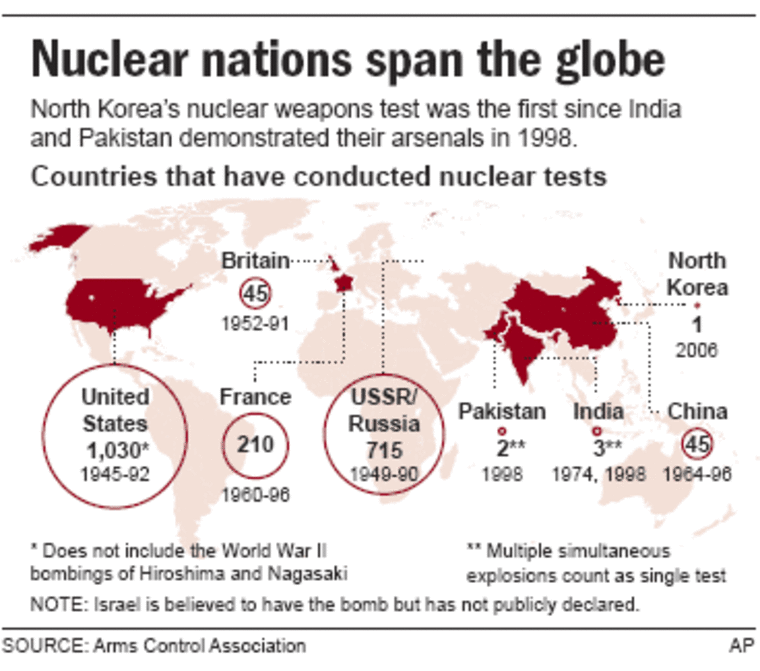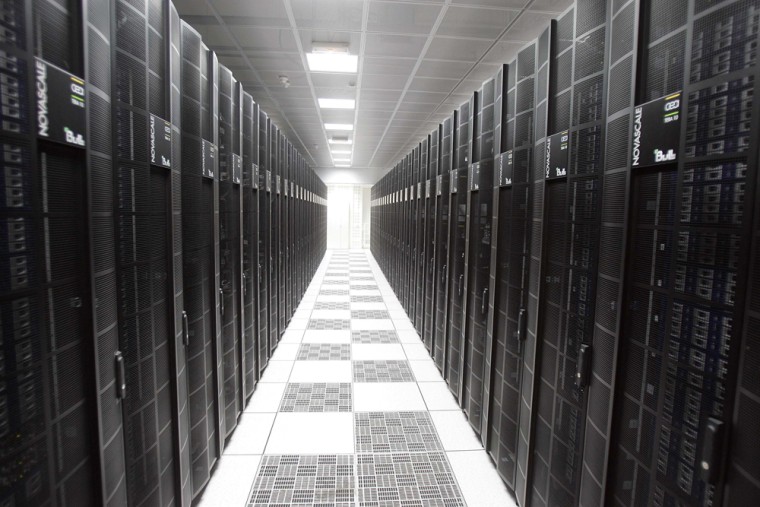While North Korea was testing a nuclear bomb, France was verifying its nuclear arms, too — with a battalion of soundless, black, cabinet-sized calculators buried beneath a meadow.
The world's established nuclear powers have for the past decade foregone real test blasts for the onscreen kind, harnessing the world's most powerful computers to simulate as best as possible what happens when a nuclear bomb explodes.
So why should any nation test-blast weapons anymore if supersimulators can do the job? Because, nuclear experts say, it has turned out to be tougher than most people thought to mimic the "real thing."
Scientists working in this secretive compound at Bruyeres-le-Chatel, south of Paris, are still several years away from being able to replicate nuclear fusion, or trying out a new bomb design without detonating it. Their American counterparts are only slightly closer, despite billions of dollars spent on supercalculators and superlasers.
"We're not really there yet," said Don Johnston, spokesman for supercomputing programs at Lawrence Livermore National Laboratory, a U.S. government nuclear research facility in California. "The more you find out, the more you realize you don't know."

North Korea's test deep inside a mountain last week sent shivers across the globe, revived fears of a nuclear apocalypse and talk of test bans, and drew new attention to these simulation efforts.
In the most basic nuclear weapon, like that dropped on Hiroshima, two loads of highly enriched uranium are slammed together to create a critical mass, a fission chain reaction, and a blast.
Most modern weapons are implosion devices, in which conventional explosives surround a radioactive core and rapidly compress it into a supercritical state.
While computers can't imitate the heat and pressures of these processes, they can perform trillions of calculations per second to predict how existing weapons will deform with age. And scientists can use conventional explosives to simulate implosion, and snap superfast photos of the process with complex X-ray machines.
This is valuable to any army holding a stockpile of aging nuclear arms — especially those who have pledged to abandon the big radioactive bangs in the desert and oceans of decades past.
Didier Besnard describes the simulation program he runs for France's Atomic Energy Commission as the "responsible option."
Anti-nuclear activists concede that simulators are safer than plutonium clouds, but oppose them in principle: They want disarmament, not costly projects that keep nuclear weapons alive.
Mike Townsley of Greenpeace expressed concern that countries could return to testing if computers can't keep up with the weaponry.
He also warned that simulation technology could pose a proliferation risk. "Will we see a black market in nuclear bits and bytes?" he asked.
Nuclear scientists defend supercomputers, saying that they can also be used for medical and environmental research, too. Supercomputers were used to help map the human genome.
France conducted its last nuclear tests in 1995-96 to glean a last round of data before giving up test blasts in favor of full-time simulations.
Today, computer scientists, physicists and other experts at the Bruyeres-le-Chatel use that data as a baseline when they analyze colorful computer graphs that bulge out like warped balloons or plunge into deep canyons.
During the Cold War, nuclear test blasts were at the core of the defense strategy of the United States, the Soviet Union, France, Britain and China. Israel is believed to have nuclear weapons but has not announced tests. India and Pakistan formally joined the nuclear club in the late 1990s with tests of their own.
None has blown up a bomb since. Dozens of countries joined the Comprehensive Test Ban Treaty in 1996, but it cannot come into force until others sign on. Notable holdouts include the United States, India, Pakistan, and North Korea.
Meanwhile, simulation efforts continue. The strongest players are the United States and France, according to Philip Coyle, senior adviser to the Center for Defense Information in Washington.
At the heart of France's program to test its 300 or so warheads is the Tera-10 supercomputer, capable of 50 teraflops, or 50 trillion calculations, per second.
Little green lights flicker from the scores of black cabinets that line the underground chamber that houses it, the only sign of activity in the silent, football field-sized hall. No humans enter the chamber, except the occasional maintenance worker. Only carefully authorized humans enter the surrounding territory at all.
The people involved in this project are found in nondescript offices scattered nearby and at other sites in France. In one office, post-it notes tile the desk beneath an average-looking computer — but its classified contents mean it must be switched off and locked before outsiders can enter the room.
These supercomputers can predict parts of a nuclear blast. To complete the picture, France and the United States are looking to superlasers to create fusion ignition — which is what happens when a hydrogen bomb explodes.
The U.S. government has put 15 years and $3 billion into its National Ignition Facility, but is now saying it has no guarantees that it will be able to produce fusion after all.
Both the NIF and the French Laser Megajoule project are estimated to go on line in 2009, though the dates have been repeatedly pushed back.
The pressure is on to get the simulation technology up to speed in time to test the first new American nuclear weapon since 1991. The United States has one of the biggest stockpiles but it's getting old, and the government is planning a fresher weapon, the Reliable Replacement Warhead, that could be developed without underground blast tests. The U.S. government is expected to choose an RRW design next month.
Western governments were pressured into halting tests when the end of the Cold War called nuclear arsenals into question. But Coyle, a former nuclear scientist, worries that information gleaned over 50 years of testing could be lost.
"In all the years I was involved in underground testing, time and again we were surprised. Something would happen that we wouldn't expect," he said. "We would realize that we didn't understand everything about the weapon."
"There's no simulation like the real thing."
